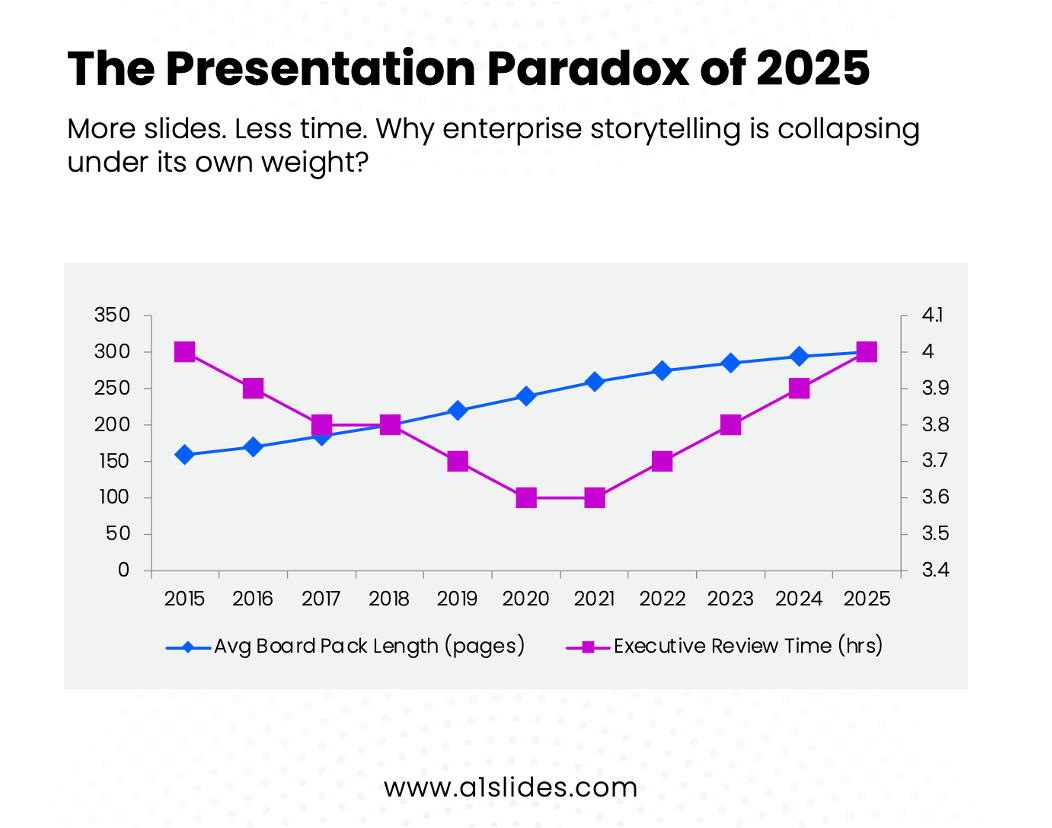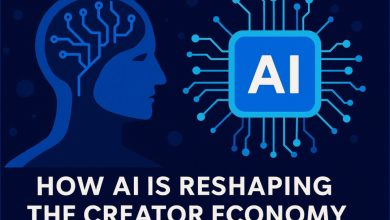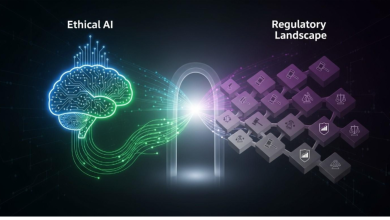In the high-stakes environment of an enterprise presentation, trusting an AI with your core message is a significant strategic risk. AI tools are built to generate volume; C-suite leaders demand decision velocity.
By creating more clutter, faster, AI often widens the “Insight-to-Action Gap” that executives already struggle with. The solution is not to reject the technology, but to put it in its proper place: as a powerful tool directed by an expert human.
TL;DR (Boardroom Ready)
- The Problem: Executives have less time to review decks that are longer than ever. Generative AI accelerates this “Presentation Paradox” by mass-producing clutter.
- Why AI Fails: It lacks three things the C-suite requires: strategic precision (it gives data dumps, not insights), executive context (it can’t “read the room”), and verifiable accuracy (hallucinations are a multi-million dollar liability).
- The Solution: Demote AI from strategist to assistant. Use an “Expert-in-the-Loop” framework where AI handles data harvesting and humans drive the narrative structure and insight generation.
The AI Presentation Paradox
The boardroom is already facing an information crisis.
A1 Slides Enterprise Presentation Outlook report identified a critical “Presentation Paradox”:
as data volumes have exploded, board decks have grown 35-40% longer than five years ago. In that same period, executive review time has contracted by 25-30%.
Executives have less time to review more material.
Generative AI is pouring fuel on this fire. It makes it easy to produce 50 slides when only 10 are needed, burying the one crucial insight in a mountain of well-designed, but strategically empty, clutter.
Why AI Fails the “Boardroom Test”
AI tools are impressive, but they lack the judgment required for high-stakes communication. They consistently fail three critical tests.
- Failure 1: AI Optimizes for Completion, Not Precision
An AI’s goal is to finish the prompt. It will fill a slide with text and charts, but it cannot identify the one insight that drives a decision. Enterprise leaders, however, demand precision: one slide, one decision-driving idea. An AI delivers a data dump; an expert delivers a narrative.
- Failure 2: AI Lacks Executive Context
A high-stakes enterprise presentation is an act of persuasion. It requires reading the room, understanding organizational politics, and pre-empting unspoken objections. AI has no emotional intelligence. It cannot build a narrative that builds consensus or navigate the complex human dynamics of the C-suite.
- Failure 3: AI Hallucinates—and You Own the Liability
In a blog post, an AI “hallucination” is an embarrassing error. In a boardroom, it’s a catastrophe.
For a healthcare presentation, every claim must meet stringent regulatory compliance. For an investor deck, every recommendation must be backed by verifiable evidence.
A “hallucinated” data point isn’t just a mistake; it’s a multi-million dollar liability.
As a McKinsey & Company report on the topic notes, “Generative AI’s potential is unprecedented, but so are the risks… Companies must manage risks, such as those related to data privacy, security, intellectual property… and, of course, accuracy and fairness.”
The Solution: The “Expert-in-the-Loop” Framework
The answer isn’t to ban AI.
It’s to demote it from strategist to assistant. The human expert must remain the architect of the message.
This gap between AI potential and real-world production is a known challenge.
Gartner research predicts that “by 2027, 80% of enterprise data and analytics leaders will have failed to move their AI initiatives from pilot to production.” The missing link is often the expert-led strategy to manage AI’s output.
Here is a simple framework for a productive partnership:
| Task Type | Use Generative AI For (The Assistant) | Use Human Experts For (The Architect) |
| Data | Data Harvest & Filtering: Sifting through 100% of raw data. | Insight Generation: Analyzing the data to find the one key message. |
| Content | First-Draft Summaries: Condensing internal reports or research. | Narrative Structuring: Arranging insights into a logical, persuasive story. |
| Design | Basic Charting: Creating a first-draft bar chart from a clean spreadsheet. | Data Visualization: Designing a chart that proves the slide’s key insight. |
| Review | Spell-Checking: Identifying basic grammatical errors. | Risk Mitigation: Verifying every data point for 100% precision and compliance. |
Conclusion: Clarity is a Strategy, Not an Algorithm
Generative AI is a powerful assistant, but it’s fundamentally like a calculator. A calculator can run numbers, but it can’t tell you what they mean or what to do about them. You wouldn’t trust it to set your financial strategy.
In the enterprise, presentations are not just documents; they are decision-enablers.
True strategic clarity doesn’t come from an algorithm. It comes from the rigorous, human-led process of Insight-First Design —where the insight is the hero and the design is its guide.





